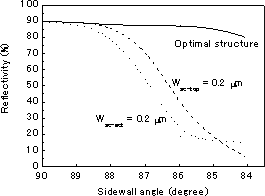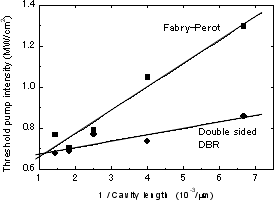Physical Science Laboratory
Å@InGaN/GaN lasers are attracting a great deal of attention as blue-violet light sources for the next generation of storage systems such as the Blu-ray Disc. However, the operating current of InGaN/GaN lasers is much higher than that of conventional GaAs/AlGaAs or GaInAsP/InP lasers. One reason for this high threshold is their low facet reflectivity of only about 18%, which results from the low refractive indices of GaN-based materials of about 2.5. The lifetime of InGaN/GaN lasers is strongly dependent on the operating current, which must therefore be reduced. To achieve this, multiple dielectric films are usually coated on the facets, but this adds extra processing steps to laser fabrication. A promising alternative structure for laser mirrors is a deeply etched distributed Bragg reflector (DBR)[1].
Å@We have achieved high reflectivity by deeply etched InGaN/GaN DBR mirrors with tilted sidewalls, which are appropriately designed by using the finite-difference time-domain method[2] (Fig.1). The predicted optimal structure is different from the simple design consisting of a λ/(4n) semiconductor and λ/4 air. If the sidewall of the grating is tilted by 4o, the reflectivity of the DBR mirrors decreases to less than 40% (dashed line, dotted line). However, any degradation in the reflectivity of a perfectly vertical sidewall can be suppressed to just a few percent even with a sidewall tilt of 4o, if the DBR structure is properly designed (solid line). We fabricated InGaN/GaN multiple-quantum well lasers based on the optimal design. The devices operate as lasers with optical pumping at a lower threshold than devices without DBR mirrors. The DBR mirror reflectivity is characterized by the relation between the threshold pump intensity and the inverse of the cavity length, resulting in a high reflectivity of 62% (Fig. 2).
[1] H. Wang et al., Jpn. J. Appl. Phys. Part 2, 41 (2002) L682.
[2] H. Wang et al., Appl. Phys. Lett., 81 (2002) 4703.
 |
 |
||||
|
|